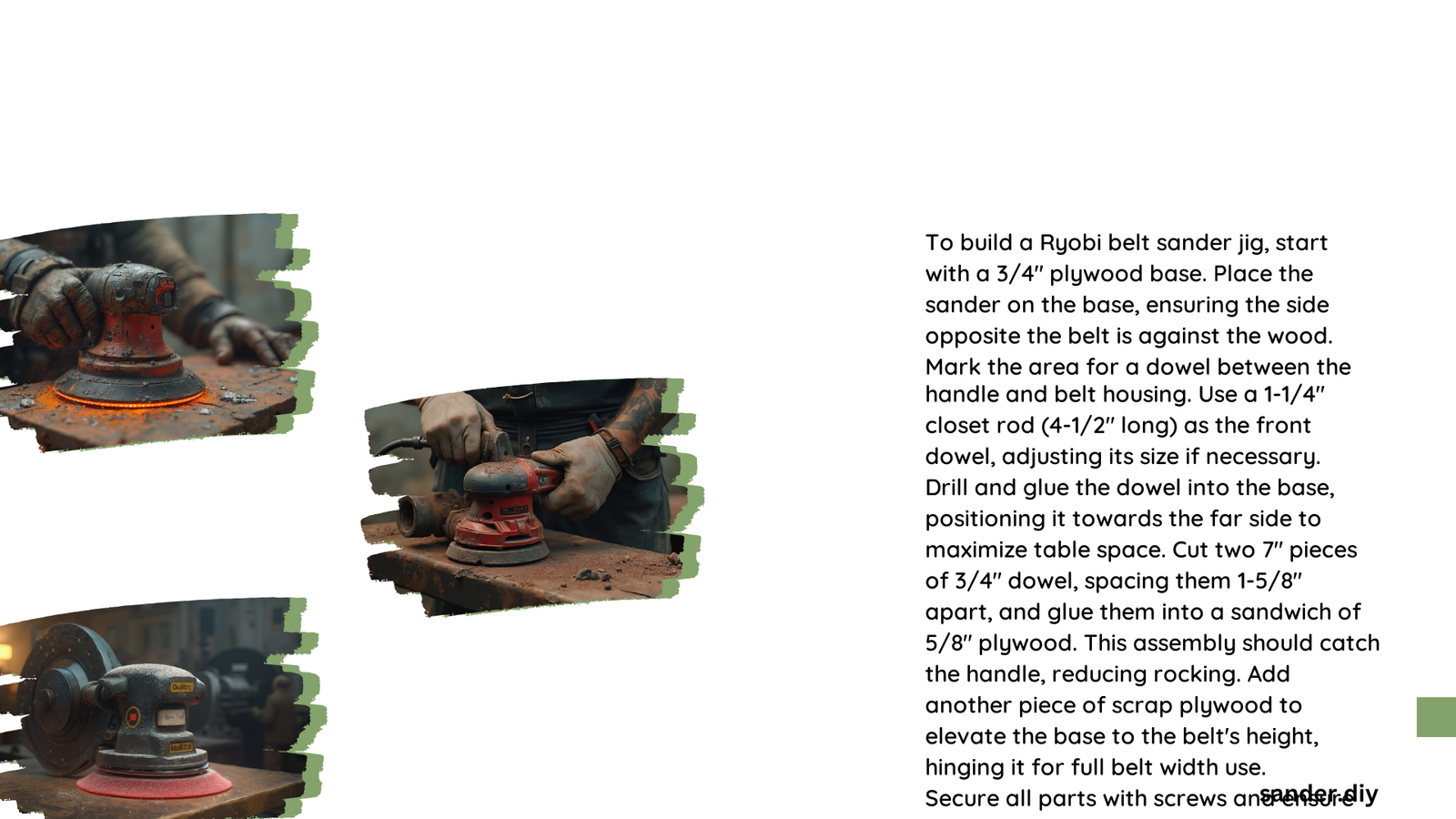A Ryobi belt sander jig is a custom-built attachment that transforms a handheld belt sander into a stationary sanding station. This jig enhances stability, improves dust collection, and allows for versatile sanding tasks. By securely holding the sander in place, it enables both horizontal and vertical sanding, making it an invaluable tool for woodworkers and DIY enthusiasts. The jig features custom-cut sides, adjustable angles, and easy trigger access, all designed to maximize the functionality of your Ryobi belt sander.
What Materials Are Needed for a Ryobi Belt Sander Jig?
To build a Ryobi belt sander jig, you’ll need the following materials:
- 3/4\” plywood for the base and sides
- 5/8\” plywood for additional support pieces
- 1-1/4\” closet rod or dowel for the front support
- 3/4\” dowel for the rear handle support
- Wood screws
- Wood glue
- Hinges (for adjustable sections)
- Retaining straps or screws (optional)
How to Construct a Ryobi Belt Sander Jig?

Follow these step-by-step instructions to build your Ryobi belt sander jig:
- Base and Sides:
- Cut two pieces of 3/4\” plywood to fit your Ryobi belt sander’s shape.
- Trace the outline of the motor housing and belt area on the plywood.
-
Custom-cut the sides to fit your specific sander model.
-
Front Dowel Support:
- Cut a 1-1/4\” closet rod or dowel to about 4-1/2\” long.
-
Drill and glue this dowel into the base, positioning it towards the far side.
-
Rear Handle Support:
- Cut two pieces of 3/4\” dowel, each about 3.5\” long.
-
Drill and glue these into a sandwich of two 5/8\” plywood pieces, spaced 1-5/8\” apart.
-
Adjustable Section:
- Cut an additional plywood piece to wrap around the front of the sander.
-
Hinge this piece to the base for adjustability.
-
Trigger Notch:
- Cut a notch in the sides for easy access to the sander’s trigger.
What Are the Key Features of a Ryobi Belt Sander Jig?
A well-designed Ryobi belt sander jig offers several key features:
- Adjustable Angles: The hinged section allows for both vertical and horizontal sanding.
- Locking Mechanisms: Retaining straps or screws secure the adjustable section.
- Custom-Cut Sides: Provides a tight fit around the sander for stability and reduced vibration.
- Trigger Notch: Allows easy access to the sander’s trigger without removal from the jig.
- Enhanced Dust Collection: Aligns with the sander’s dust port for improved efficiency.
How to Properly Align and Set Up the Ryobi Belt Sander Jig?
Proper alignment and setup are crucial for optimal performance:
- Leveling:
- Ensure the jig’s base is level on your work surface.
- Position the sander securely within the custom-cut sides.
-
Adjust sides if necessary to keep the sanding belt parallel to the base.
-
Trigger Access:
-
Verify the trigger notch is correctly positioned for easy access.
-
Belt Alignment:
- Adjust the belt to ensure proper alignment and tension.
-
Ensure easy access to the belt tracking knob and tension release mechanism.
-
Calibration Measurements:
- Double-check that the sander is securely positioned within the jig.
- Verify all supports are in place and functioning correctly.
What Are the Benefits and Challenges of Using a Ryobi Belt Sander Jig?
Benefits:
- Enhanced stability and reduced vibration
- Improved dust collection efficiency
- Adjustable angles for versatile sanding tasks
- Easy access to the trigger
- Transforms handheld sander into a stationary tool
Challenges:
- Requires precision in custom-cutting sides to fit specific sander model
- Proper alignment and leveling are crucial for optimal performance
- May limit portability of the sander when attached to the jig
How to Enhance the Functionality of Your Ryobi Belt Sander Jig?
To maximize the utility of your Ryobi belt sander jig, consider these enhancements:
- Dust Collection System:
- Design the jig to align perfectly with the sander’s dust port.
-
Add a connection point for a shop vacuum or dust collection system.
-
Work Surface Extensions:
- Attach removable side tables to increase the work surface area.
-
Use T-tracks on extensions for attaching jigs or stops.
-
Angle Gauge:
-
Install a simple angle gauge to the adjustable section for precise angle settings.
-
Storage Solutions:
-
Add built-in storage compartments for sandpaper and accessories.
-
Mobility:
- Consider adding locking casters to the base for easy movement around the workshop.
By implementing these features, you can create a versatile and efficient Ryobi belt sander jig that enhances your woodworking capabilities and improves your overall sanding experience.
